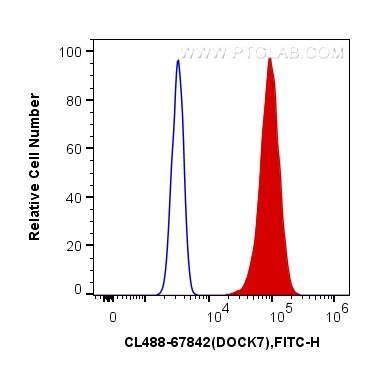DOCK7 Monoklonaler Antikörper
DOCK7 Monoklonal Antikörper für FC (Intra)
Wirt / Isotyp
Maus / IgG2b
Getestete Reaktivität
human, Maus, Ratte
Anwendung
FC (Intra)
Konjugation
CoraLite® Plus 488 Fluorescent Dye
CloneNo.
1A4A6
Kat-Nr. : CL488-67842
Synonyme
Geprüfte Anwendungen
| Erfolgreiche Detektion in FC (Intra) | HeLa-Zellen |
| Erfolgreiche Detektion in FC | HeLa-Zellen |
Empfohlene Verdünnung
| Anwendung | Verdünnung |
|---|---|
| Durchflusszytometrie (FC) (INTRA) | FC (INTRA) : 0.40 ug per 10^6 cells in a 100 µl suspension |
| Durchflusszytometrie (FC) | FC : 0.40 ug per 10^6 cells in a 100 µl suspension |
| It is recommended that this reagent should be titrated in each testing system to obtain optimal results. | |
| Sample-dependent, check data in validation data gallery | |
Produktinformation
CL488-67842 bindet in FC (Intra) DOCK7 und zeigt Reaktivität mit human, Maus, Ratten
| Getestete Reaktivität | human, Maus, Ratte |
| Wirt / Isotyp | Maus / IgG2b |
| Klonalität | Monoklonal |
| Typ | Antikörper |
| Immunogen | DOCK7 fusion protein Ag28417 |
| Vollständiger Name | dedicator of cytokinesis 7 |
| Berechnetes Molekulargewicht | 2109 aa, 239 kDa |
| Beobachtetes Molekulargewicht | 243 kDa |
| GenBank-Zugangsnummer | BC016392 |
| Gene symbol | DOCK7 |
| Gene ID (NCBI) | 85440 |
| Konjugation | CoraLite® Plus 488 Fluorescent Dye |
| Excitation/Emission maxima wavelengths | 493 nm / 522 nm |
| Form | Liquid |
| Reinigungsmethode | Protein-A-Reinigung |
| Lagerungspuffer | PBS with 50% glycerol, 0.05% Proclin300, 0.5% BSA |
| Lagerungsbedingungen | Bei -20°C lagern. Vor Licht schützen. Nach dem Versand ein Jahr stabil. Aliquotieren ist bei -20oC Lagerung nicht notwendig. 20ul Größen enthalten 0,1% BSA. |
Hintergrundinformationen
DOCK 7 (dedicator of cytokinesis 7), also known as ZIR2, is a member of the DOCK180-related protein superfamily. Expressed mainly in neuronal cells, DOCK 7 is a guanine nucleotide exchange factor (GEF) for small GTPases, Rac1 and Cdc42, which are the major regulators of actin cytoskeleton. Multiple isoforms of DOCK 7 exist due to alternative splicing events.
Protokolle
| PRODUKTSPEZIFISCHE PROTOKOLLE | |
|---|---|
| FC protocol for CL Plus 488 DOCK7 antibody CL488-67842 | Download protocol |
| STANDARD-PROTOKOLLE | |
|---|---|
| Klicken Sie hier, um unsere Standardprotokolle anzuzeigen |


